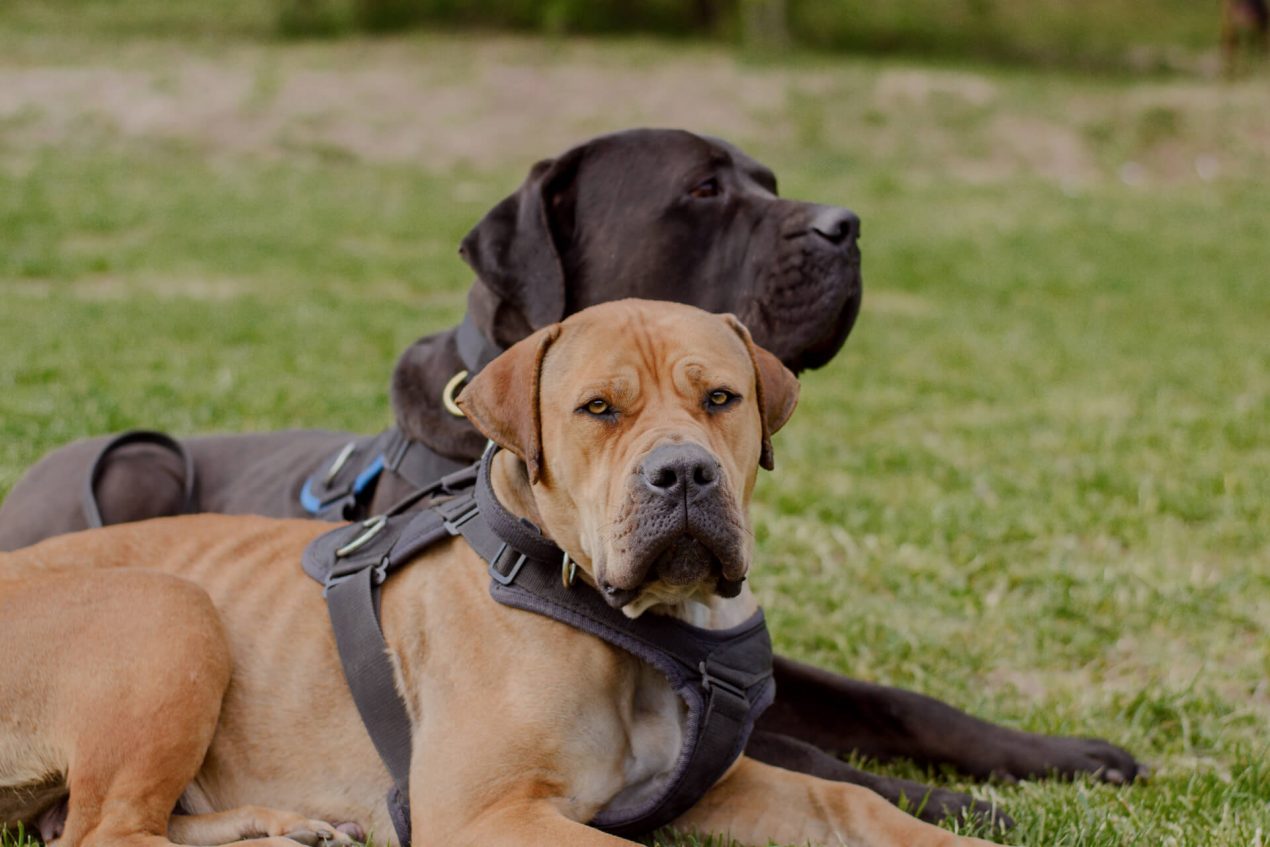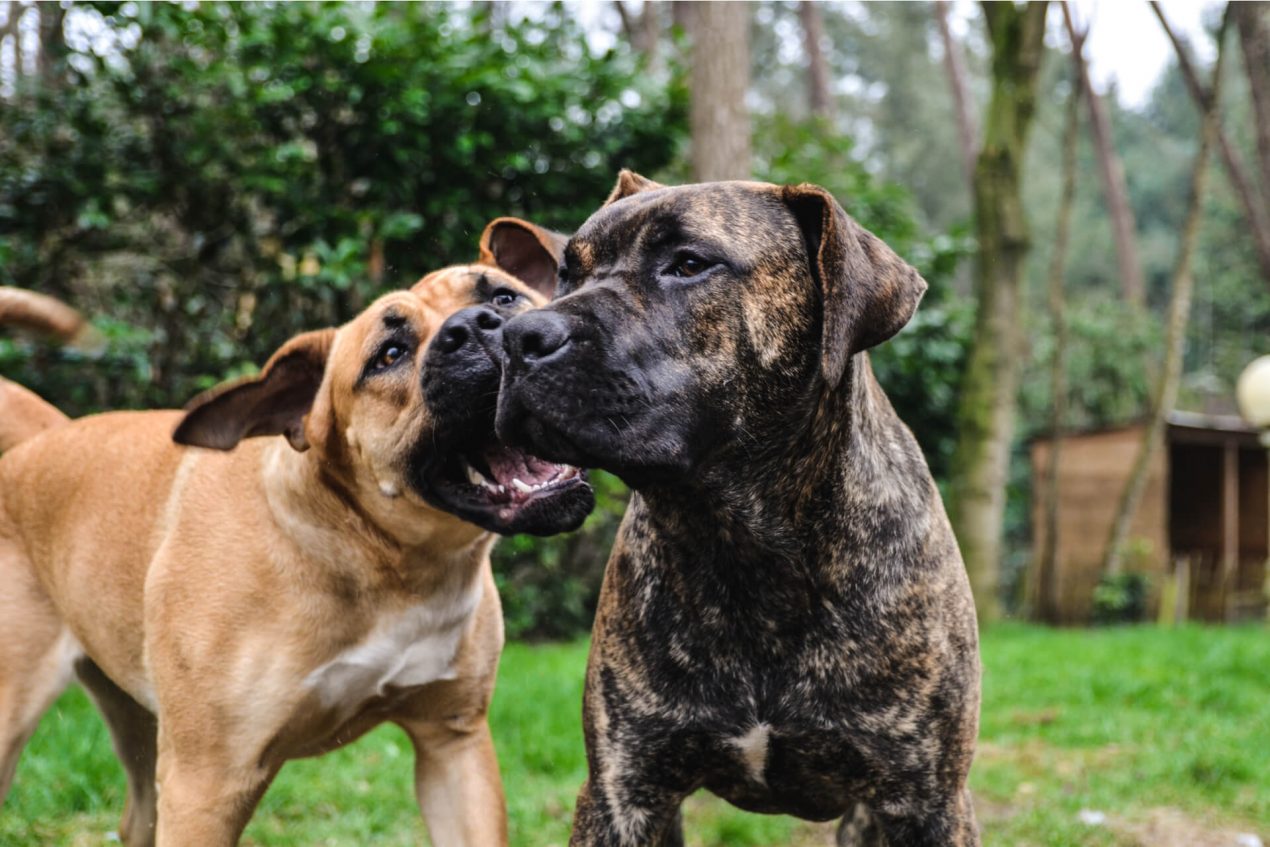Muscular and impressively sized, the Boerboel, known as a guard and protection dog, commands respect. However, this intelligent dog is also known for its patience and loyalty, making it an excellent family-friendly companion that will surely capture your heart.
History of the Boerboel
When we talk about the Boerboel, we’re essentially referring to the South African Mastiff. The history of the breed dates back to 1652 when the Dutch administrator Jan Riebeecks brought a “Bullenbjiter” to the Cape region. In the following years, Dutch and British colonists also brought their dogs to South Africa, with a particular emphasis on the dogs’ ability to protect land, livestock, and families from wild animals. Consequently, numerous British Mastiffs and European mastiff-type dogs made their way to South Africa.
These dogs brought to Africa laid the foundation for the breed, as there was a need for dogs that showed no fear of predators and possessed good guarding and working qualities. However, the Boerboel was only defined as a distinct breed in 1983 by the South African Boerboel Breeders Association. The breed was recognized by the Kennel Union of South Africa, where it was classified as a Working Dog. However, recognition by the FCI is still pending. Nonetheless, the demand for South African purebred dogs is steadily increasing, even in Europe and Asia, with particularly high demand in Russia for these working dogs with pleasant and stable temperaments. The Boerboel became eligible for AKC registration, on December 1, 2014 and was eligible to compete in the Working Group, beginning January 1, 2015.
Breed Overview
GROUP: Working
HEIGHT: 22 to 25 inches (female), 24 to 27 inches (male)
WEIGHT: 150 to 200 pounds
COAT: Short, smooth
COAT COLOR: Brindle, brown, cream, red, reddish brown, or tawny with/without white markings, black mask, piebald, and/or Irish marked
LIFE SPAN: 9 to 11 years
TEMPERAMENT: Courageous, alert, protective
HYPOALLERGENIC: No
ORIGIN: South Africa
Temperament and Character
Extremely alert, brave, fearless, and confident, the Boerboel moves through the world with certainty. These qualities, combined with its impressive appearance, may raise questions for some. First, to the most important question: Is a Boerboel a family dog? The answer is yes, as the Boerboel possesses other qualities that make it a good family and companion dog.
The Boerboel is patient, seemingly devoid of aggression. It is naturally fond of children and gets along well with cats. It is loyal and affectionate but can also be left alone due to its independence and takes its role as a guard dog seriously. Otherwise, the Boerboel is generally a calm companion that barks infrequently. However, it does have a certain need for activity and playfulness. Therefore, it requires an active owner who can guide the Boerboel’s boundaries with loving firmness.
| Affection Level | High |
| Friendliness | Medium |
| Kid-Friendly | Medium |
| Pet-Friendly | Low |
| Exercise Needs | Medium |
| Playfulness | Medium |
| Energy Level | Medium |
| Trainability | High |
| Intelligence | High |
| Tendency to Bark | Medium |
| Amount of Shedding | Medium |
Acquiring a Boerboel
Before considering the acquisition of a Boerboel, there are several factors to consider. The breed is not suitable for novice owners, and you should only consider a Boerboel if you are an experienced dog owner who knows how to lovingly and firmly train this somewhat complex dog. Questions often arise about Boerboels.
Is the Boerboel a fighting dog? This question is not straightforward to answer, as the dog is considered a restricted breed in some countries due to its bite force of 800 PSI. However, in terms of temperament, the dog is more of a family-friendly guard dog and, with proper socialization, does not exhibit aggression. In the United States, the breed is not classified as restricted, but you should check with the relevant authorities as some states may impose conditions on owning the breed.

What Should I Consider When Buying?
Fundamentally, purchasing a Boerboel should not be impulsive. Beforehand, consider whether you can meet the needs of this breed. Even if a Boerboel puppy warms your heart, you must realize that as an adult, the dog will reach an impressive size, which alone can be intimidating to some people. Only choose a Boerboel if you can truly provide a loving and suitable home for the dog throughout its life. Only purchase a puppy from a reputable Boerboel breeder registered with a breed association. In Europe this can be challenging as the breed is not yet recognized by the FCI.
However, it’s worth the effort to find a reputable breeder. Locally, ensure that the Boerboel puppies are raised within a family environment, as this initiates socialization. Additionally, a reputable Boerboel breeder will ask you several questions to ensure you are suitable to handle these extremely strong giants. You should also assess the parent animals and review their veterinary records.
Puppy Development and Training
If you decide to get a Boerboel puppy, be prepared to assert some level of firmness even with the puppies. Given that the African breed is very robust and intelligent, never slack off on training. Always be aware that the Boerboel, due to its size, is not an easy dog. Furthermore, due to its strength, the leash is more symbolic than a control device for adult dogs of this breed. Therefore, it is crucial to be consistent in training so that the Boerboel learns and accepts clear boundaries from an early age.
How to Care for a Boerboel?
When caring for a Boerboel, consider that it is a working dog. An enclosed, large property is perfect for the dog, as it excels as a guard dog in such an environment. A rural setting is ideal for keeping the Boerboel happy, as it will not feel comfortable in an urban apartment.

Activities with the Boerboel
How much exercise does a Boerboel need? This question arises due to its size alone. Generally, regular walks are sufficient for the dog. If possible, longer walks can also be undertaken. However, the dog will also be happy to resume guarding its territory and fulfilling its duties after a walk. The Boerboel is highly intelligent, eager to learn, and playful, making it suitable for training and learning new commands.
Health and Grooming
Regardless of whether you choose a Black Boerboel or a fawn Boerboel, the breed is very robust, and breed-specific diseases are not known. Maintenance of the breed’s short coat is unproblematic, requiring only weekly brushing. To ensure the dog’s good health, focus on a diet with a high meat content. The Boerboel is also a perfect candidate for raw feeding (BARF). However, thorough research on raw feeding is essential beforehand.
Interesting and Noteworthy
For centuries, the breed has proven itself as a courageous guardian and remains one of the most popular breeds in South Africa today. If you want to keep a Boerboel, be aware that the hustle and bustle are not ideal for the breed. Therefore, it should only be kept in rural areas with correspondingly large and secure properties.
Do you already own a Boerboel or plan to get one in the future? Feel free to share more about your experiences in the comments!


